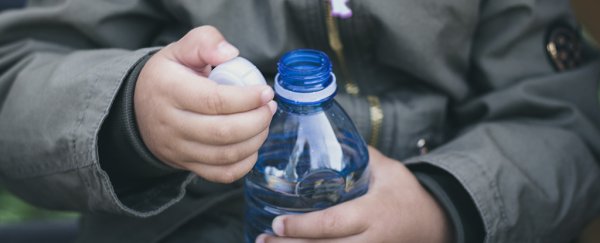Sure - after cracking open that refreshing bottle of chilled mountain spring water you have every intention of throwing it into recycling, right? Sorry to say, but just unscrewing the lid unleashes a dusting of tiny plastic particles, according to new research.
Just how much of a dusting depends on a variety of factors, but researchers from the University of Newcastle and Flinders University in Australia, and the Chinese Academy of Sciences, have put some numbers to the sizes and quantities of flakes and fibres generated every time we snap, cut, and tear a piece of plastic.
Through the application of highly precise instruments such as a quartz crystal microbalance and scanning electron microscopy, the researchers measured the effects various dissecting techniques had on common plastic items.
These included tearing open the packaging around chocolates, snipping tape and plastic bags with scissors and other blades, and twisting off the plastic cap from a bottle.
Weighing the materials before and after each application gave the team a good idea of the amount of mass they each shed, presumably to a rain of tiny scraps of plastic too tiny to see.
Some of these itty-bitty particles could be swept up and analysed visibly with a microscope and chemically with a spectrometer, further providing a description of the waste we don't consider when using single use plastics.
Broadly speaking, it seems we're releasing anywhere around 10 to 30 nanograms of plastic fragments just a few nanometres across for every 3 metres (about 10 feet) of plastic we break apart.
Putting it into perspective, assuming a plastic straw weighs just under half a gram, you'd need to cut around 150,000 kilometres of plastic to generate the equivalent mass of microplastic waste. That distance would stretch nearly halfway to the Moon.
Should we be worried, then? It might seem trivial, but combined with the microplastics embedded in cosmetics, shed from clothing, and generated during industrial production, it's going to add up.
This microscopic waste has attracted attention in recent years as an 'invisible' pollution stretching across our oceans and atmosphere, finding their way into just about every corner of the globe.
Unlike the fragments of old buckets and torn plastic bags we find choking up our wildlife, it's harder to picture the potential harm these plastic flakes might cause.
There's good reason to suspect it's plugging up the guts of tiny filter feeders, but how this impacts the rest of the food chain – including us humans – is yet to be shown.
While we wait for the scientific jury to come back with a verdict on just how concerned we ought to be, the mass of microscopic plastic pieces continues to pile up.
By 2060, we might expect as much as 265 million tonnes of plastic waste to have accumulated in the natural environment. Just over 13 percent of this will be pieces smaller than 5 millimetres (1/5 of an inch) in size.
The study did find different dissection methods could fairly reliably generate greater and lesser amounts of microplastic waste.
Scissoring and tearing with your hands gave fairly similar results, while using a knife to slice through plastic materials released significantly more waste.
Some items created larger fragments, such as the tearing apart of plastic lids as you open a bottle.
For all practical purposes, the research doesn't provide us with a solid solution for eliminating the invisible fog of microplastic we release as we snip and tear out way through our daily lives.
Sure, we might think twice now before mindlessly ripping up plastic waste before popping it into recycling.
But really, at best it's just one more piece of evidence in support of avoiding plastics wherever possible in the first place.
This research was published in Nature Scientific Reports.
